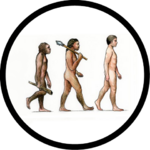Future of the World
From Saecula Novae

|
This speculative evolution is a featured article!
|
There are many documentaries showing future evolution, such as The Future is Wild and After Man: A Zoology of the Future. This page is a prediction of what will happen to the fauna of the world, from various million years from the future. The Future of the World is a community project, but unapproved animals go in the candidates section.
Five Million Years Later
The world is gripped by a global ice age. The ice from the poles reach as far south as Paris and as far north as Buenos Aires.
Climate
It's the dawn of a brand new ice age. Human's population has greatly declined over the years, and that which remains are huge existing societies that are surviving pockets of large cities, such as New York or Paris. Much of the world's fresh water is locked up in the Earth's huge ice caps, which reach as far south as Paris for the Northern ice cap and north to Buenos Aires for the Southern ice cap. On the edges of the ice, animals have adapted to the bitter cold and vicious winters; in the tropics, the rainforest has almost disappeared, mostly replaced by moist savannah and drier, though still fairly wet, tropical forests.
Fauna
The fauna of this time is fairly similar to ours, but due to the extinction that wiped out many species, several major groups have drastically declined--examples include pachyderms, species in the Amazon, and the largest species of the order Carnivora. For the most part, hoofed mammals have replaced pachyderms, resulting in them growing much larger.
Places
Twenty Five Million Years Later
The earth has finally began to warm in ten million years. Creatures from the old ages have to adapt to the warmer climate. The human's natural range has reached it's maximum, as well as their ecological impact. Earth's climate is generally warming up; it is the end of the ice ages. With this, life will face another challenge soon.
Climate
Together with the humans thriving, their cities have greatly increased their size. Though some cities that are small and less important, have turned into hills of falling debris. The Earth's climate at this age is continental, ranging to a never before seen array of habitats. Yet change is in the air--a sudden increase in volcanic eruptions pours greenhouse gases into the atmosphere, the planet begins to warm up to a temperature like today, and the melting ice creates massive, devastating floods, which will soon change the fauna and the habitats of Earth.
Fauna
The fauna of this time is fairly similar to ours, but the Earth's diversity of lifeforms have increased, specially, the avians and the mammals. Amphibians are recovering rapidly from previous times, and are filling insectivorous and semi-aquatic niches quickly. Fishes are thriving, though they show less morphological change, as a group. The reptiles haven't changed that much, but one group--the neomosasaurians--are thriving and are replacing many marine mammals in the southern hemisphere, though most of the clade's species are restricted to Southeast Asia and Oceania.

